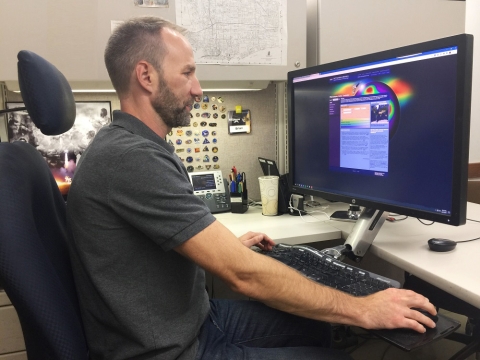Brian Knosp, Scientific Applications Software Engineer, NASA’s Jet Propulsion Laboratory (JPL) at the California Institute of Technology
Research interests: Database development and software engineering, with the goal of finding better ways to make Earth observing data available to science teams.
Research highlights: When a sensor aboard an Earth observing satellite collects data, these data are strings of numbers representing physical properties of the area being sampled. In their raw state, these data are difficult if not impossible to use until they are processed into individual data product files. Processing Earth observing data into thousands of useful data products and getting these products to one of NASA's discipline-specific Distributed Active Archive Center (DAAC) is a principal task of the Earth Observing System Data and Information System (EOSDIS). This work relies not only on powerful computers, but also on skilled software and systems engineers who continuously adjust and improve systems and products to ensure that NASA Earth observing data accurately and precisely represent physical processes, meet the needs of science teams, and are delivered as rapidly as possible to data users.
Brian Knosp’s work at JPL deals with managing large Earth science data sets and making them accessible to various science teams, both at NASA and at numerous other organizations using these data. As Knosp points out, there are many ways to make data “accessible.” Accessible can simply mean making the data available on a local filesystem or ingesting data into a database where science analysis tools can be used to intelligently search for the data. Still another way data can be made accessible is by plotting data on maps and statistical graphs that can be used by science teams and even the general public.
Many of the data sets Knosp works with are standard data products that have the extensive processing, quality assurance (QA) reviews, and validation necessary for use in scientific research. He also works with near real-time (NRT) data, which do not have the extensive processing and validation required for use in scientific research, but are available generally within hours of a sensor overpass and are a valuable resource for managing on-going events.
While Knosp works with data from numerous individual instruments aboard NASA Earth observing satellites as well as with model data, his primary work is as the Data Operations Manager for the Microwave Limb Sounder (MLS) Project, which is part of NASA’s Aura mission. The Aura satellite was launched in 2004 to collect data about ozone, aerosols, and atmospheric gases. MLS is one of Aura’s four instruments, and measures atmospheric gases, temperature, pressure, and cloud ice. Knosp is responsible for cataloging mission data at the MLS Science Computing Facility (SCF) at JPL, which receives standard MLS data products from the MLS Science Investigator-led Processing System (MLS SIPS), which also is located at JPL. Once these processed data arrive, Knosp and his colleagues sort them, ingest them into a database, incorporate them onto standard plots, and send them to external sources such as the EOSDIS Worldview system or NASA’s Eyes on the Earth application.
Knosp also works on the Orbiting Carbon Observatory-2 (OCO-2) mission. OCO-2 launched in July 2014 to collect global measurements of atmospheric carbon dioxide (CO2). OCO-2 data help characterize regional CO2 sources and sinks, and provide precise measurements of CO2 variability over yearly seasonal cycles. Knosp specifically works with the CO2 Virtual Science Data Environment, which brings together different CO2 data sets and allows users to customize CO2 data products.
Another major project on which Knosp works is the JPL Tropical Cyclone Information System (TCIS). TCIS was originally a development project that started out of a need to collect hurricane data in one central location. Today, the TCIS system is used in multiple NASA airborne campaigns to provide NRT large-scale basin environmental information and as a research tool for information about past storms. TCIS provides data and visualizations for studying hurricane processes, validating and improving models, and developing new algorithms and data assimilation techniques.
As the TCIS database lead, Knosp is in charge of developing the TCIS database architecture used to store different types of satellite, model, and aircraft data sets. He notes that these data sets need to be quickly searched so that plots can be presented to users on a virtual globe in a web browser. An integral part of his work entails making sure the TCIS databases are finely tuned so that database queries run quickly and users do not wait long to access data.
Knosp recently has been working to set up a filesystem that can be mounted to multiple science computing centers at JPL so that research teams can share large data sets like the Modern-Era Retrospective analysis for Research and Applications, Version 2 (MERRA-2) and the European Centre for Medium-Range Weather Forecasts' (ECMWF) ERA-5. This requires setting up a system of software to routinely download, compress, and catalog data, which enables science teams to access data in a central, local location that could, in the future, be moved to a computing cloud-based solution.
Knosp points out that while he does not personally conduct scientific research using Earth science data, his work makes these data available rapidly and in the wide range of formats needed by those who do. The behind-the-scenes work of engineers like Brian Knosp is vital to fulfilling the EOSDIS mission of ensuring that NASA Earth observing data are fully and openly available to data users around the world.
Representative data products used most often:
- Available through the Goddard Earth Sciences Data and Information Services Center (GES DISC)
- Microwave Limb Sounder (MLS)
- Orbiting Carbon Observatory-2 (OCO-2)
- MERRA-2 3d,3-Hourly,Instantaneous,Model-Level,Assimilation,Assimilated Meteorological Fields V5.12.4 (M2I3NVASM, doi:10.5067/WWQSXQ8IVFW8)
- Ozone Monitoring Instrument (OMI)/Aura Ozone (O3) Total Column 1-Orbit L2 Swath 13x24 km V003 (OMTO3, doi:10.5067/Aura/OMI/DATA2024)
- Atmospheric Infrared Sounder (AIRS)
- AIRS/Aqua L2 Standard Physical Retrieval V006 (AIRX2RET, doi:10.5067/AQUA/AIRS/DATA201)
- AIRS/Aqua L2 CO2 in the free troposphere V005 (AIRX2STC, doi:10.5067/AQUA/AIRS/DATA218)
- AIRS NRT data
- Available through the Atmospheric Science Data Center (ASDC)
- Tropospheric Emissions Spectrometer (TES)/Aura L2 Carbon Monoxide (CO) Nadir (TL2CON, doi:10.5067/AURA/TES/TL2CON_L2.007)
- Cloud-Aerosol Lidar and Infrared Pathfinder Satellite Observations (CALIPSO)
- CAL_LID_L2_05kmAPro-Standard-V4-10 (doi:10.5067/CALIOP/CALIPSO/LID_L2_05kmAPro-Standard-V4-10)
- CAL_LID_L2_05kmCPro-Standard-V4-10 (doi:10.5067/CALIOP/CALIPSO/LID_L2_05kmCPro-Standard-V4-10)
- Available through the National Center for Atmospheric Research Research Data Archive
- Climate Forecast System Reanalysis-Version 1 (CFSRv1, doi:10.5065/D69K487J)
- Japan Meteorological Agency 55-year Reanalysis, Daily 3-Hourly and 6-Hourly Data (JRA-55, doi:10.5065/D6HH6H41)
- Available through the European Centre for Medium-range Weather Forecasts
Read about the work:
Manney, G.L., Hegglin, M.I., Lawrence, Z.D., Wargan, K., Millán, L.F., Schwartz, M.J., Santee, M.L., Lambert, A., Pawson, S., Knosp, B.W., Fuller, R.A. & Daffer, W.H. (2017). Reanalysis comparisons of upper tropospheric/lower stratospheric jets and multiple tropopauses. Atmospheric Chemistry and Physics Discussions, 17(18): 1-39. doi:10.5194/acp-2017-400
Knosp, B., Gangl, M., Hristova-Veleva, S., Kim, R., Li, P., Turk, J. & Vu, Q. (2015). A Look Under the Hood: How the JPL Tropical Cyclone Information System Uses Database Technologies to Present Big Data to Users. Invited Presentation at the 2015 American Geophysical Union Fall Meeting, San Francisco, CA.18 December 2015. Presentation file.
For more information
- Microwave Limb Sounder (MLS) Project
- MLS Science Investigator-led Processing System (MLS SIPS)
- Orbiting Carbon Observatory-2 (OCO-2) mission
- Tropical Cyclone Information System (TCIS)
- Modern-Era Retrospective analysis for Research and Applications, Version 2 (MERRA-2)
- Atmospheric Infrared Sounder (AIRS)
- Ozone Monitoring Instrument (OMI)
- Tropospheric Emissions Spectrometer (TES)
- Cloud-Aerosol Lidar and Infrared Pathfinder Satellite Observations (CALIPSO)


